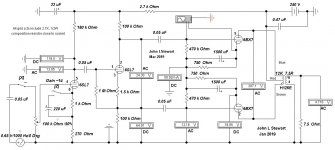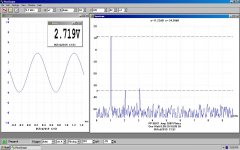If you were looking to build a stereo flea powered (.75-2wpc) amp for use in a tri amped setup which amp, tube, and or circuit would it be?
Now this amp will be connected to two 16 ohm drivers that are rated at 118db/1watt/1meter...
Now this amp will be connected to two 16 ohm drivers that are rated at 118db/1watt/1meter...
Hey Eli,
Thanks for replying and I do agree with on getting the custom windings. As far as the tubes go I am trying to get away from the 45 because of the cost to replace the EML solid plates, I don't much about the #10 tube. Thanks.
Thanks for replying and I do agree with on getting the custom windings. As far as the tubes go I am trying to get away from the 45 because of the cost to replace the EML solid plates, I don't much about the #10 tube. Thanks.
A lot of design choices.
Since output transformer does not have to reproduce low bass and high treble, it doesn't need big core, high primary inductance or interleaving.
My topology preference would be classical pentode connection, push-pull, transformer-coupled. It will provide current drive to speaker. In midrange, there isn't much variation of speaker impedance (which, BTW, will be largely resistive), as required for low distortion pentode operation.
My tube choice would be a directly-heated pentode like 1P24B, 3D6, 4P1L, 2E24, 47.
Since output transformer does not have to reproduce low bass and high treble, it doesn't need big core, high primary inductance or interleaving.
My topology preference would be classical pentode connection, push-pull, transformer-coupled. It will provide current drive to speaker. In midrange, there isn't much variation of speaker impedance (which, BTW, will be largely resistive), as required for low distortion pentode operation.
My tube choice would be a directly-heated pentode like 1P24B, 3D6, 4P1L, 2E24, 47.
Last edited:
Do you want to use negative feedback?
Refer to the others who will answer this thread, and suggest using negative feedback.
If not, read on . . .
Do you want to use a DHT and no negative feedback?
Use a 2A3 (and be sure to use DC powered heaters to eliminate Intermodulation of 2X the power mains frequency with each and every instrument music tone/music note/instrument harmonic).
Or, use a 6CK4 indirectly heated triode, and no negative feedback.
Just my opinions.
Careful, you do not want to turn the mid frequency amplifier all the way up.
You need to protect your ears, or the mid frequencies will no longer sound good (Tinnitus)
Refer to the others who will answer this thread, and suggest using negative feedback.
If not, read on . . .
Do you want to use a DHT and no negative feedback?
Use a 2A3 (and be sure to use DC powered heaters to eliminate Intermodulation of 2X the power mains frequency with each and every instrument music tone/music note/instrument harmonic).
Or, use a 6CK4 indirectly heated triode, and no negative feedback.
Just my opinions.
Careful, you do not want to turn the mid frequency amplifier all the way up.
You need to protect your ears, or the mid frequencies will no longer sound good (Tinnitus)
There is no significant benefit in using feedback in a mid-only amplifier.
But it does improve damping factor, something the speakers chosen may benefit from.🙂
What is the DCR of the "16" Ohm voice coil?
That will be part of determining the maximum damping of the drivers, even if the damping factor of the amplifier is infinite.
Want more damping per those driver characteristics, just read the posts of . . .
I am drawing blanks for the name, but he uses Negative Resistance circuits on his single ended amplifiers.
I apologize to him, how can I forget his user name? Starts with a W?
If you have not read his posts, you have not been reading Tubes / Valves nearly enough.
Get to reading the posts.
I am betting he will rescue me, and chime in with his user name.
Thanks in advance!
P.S.
1. The person I am talking about is Wavebourn.
2. Those mid range horn loaded drivers, within the frequency range of the horns, are probably very well mechanically damped.
That will be part of determining the maximum damping of the drivers, even if the damping factor of the amplifier is infinite.
Want more damping per those driver characteristics, just read the posts of . . .
I am drawing blanks for the name, but he uses Negative Resistance circuits on his single ended amplifiers.
I apologize to him, how can I forget his user name? Starts with a W?
If you have not read his posts, you have not been reading Tubes / Valves nearly enough.
Get to reading the posts.
I am betting he will rescue me, and chime in with his user name.
Thanks in advance!
P.S.
1. The person I am talking about is Wavebourn.
2. Those mid range horn loaded drivers, within the frequency range of the horns, are probably very well mechanically damped.
Last edited:
I am drawing blanks for the name, but he uses Negative Resistance circuits on his single ended amplifiers.
There were several, some published in Audio Magazine in the 50s. I did a PP amp once, just as an experiment. All worth trying to satisfy a curiosity.😀 It appeared on these pages a while ago.🙂
There were several, some published in Audio Magazine in the 50s. I did a PP amp once, just as an experiment. All worth trying to satisfy a curiosity.😀 It appeared on these pages a while ago.🙂
jhstewart9,
Thanks!
I revised my post just before you posted.
The name I could not think of is Wavebourn.
He has posted very many times on this forum for years.
Thanks!
I revised my post just before you posted.
The name I could not think of is Wavebourn.
He has posted very many times on this forum for years.
But it does improve damping factor, something the speakers chosen may benefit from.🙂
But damping only matters for main speaker resonance. If the resonance is out of the mid-band, then no damping is necessary.
Probably depends quite a bit on the mid-band speaker. Need to look at its loaded impedance curve in order to decide the best route. Many variables, more will come in this thread from others.
Depending on the OPT & load vs rp of the system, a triode without NFB the DF could look like anything from 1.5 to 5. The listener will decide.🙂
Depending on the OPT & load vs rp of the system, a triode without NFB the DF could look like anything from 1.5 to 5. The listener will decide.🙂
I went back to your first post, I see you are already committed to a pair of existing 16Z speakers. The DCR will be ~14R at mid band. Common 6BX7 or 6BL7 twin triodes in a PP OP circuit will easily provide the audio power you are looking for at low distortion. Two years ago I built several experimental models based on those & 6SN7. The results are very good.
The 6BX7 or 6BL7 are capable of a very clean 3 watts without exceeding their dissipation rating. And won't break the bank account. The OPT was a simple Hammond 125E Universal.🙂
The measured results, schematics, Etc are all well documented starting at about post 250, Fall of 2018 in Lingwendl's thread covering a 6SN7 Push Pull Flea Powered Amplifier Project. One of several versions is copied here.
The 6BX7 or 6BL7 are capable of a very clean 3 watts without exceeding their dissipation rating. And won't break the bank account. The OPT was a simple Hammond 125E Universal.🙂
The measured results, schematics, Etc are all well documented starting at about post 250, Fall of 2018 in Lingwendl's thread covering a 6SN7 Push Pull Flea Powered Amplifier Project. One of several versions is copied here.
Attachments
I agree with jhstewart9,
Look at the impedance curve of those horn loaded drivers.
When at low mid frequencies if the horn unloads, the driver may have a resonance.
And, at the upper mid frequencies, the voice coil inductance may be an issue.
Given the horn loading, a sharp cutoff high pass crossover at the low mid frequencies may be needed.
Keep those frequencies out of the amplifier input.
Look at the impedance curve of those horn loaded drivers.
When at low mid frequencies if the horn unloads, the driver may have a resonance.
And, at the upper mid frequencies, the voice coil inductance may be an issue.
Given the horn loading, a sharp cutoff high pass crossover at the low mid frequencies may be needed.
Keep those frequencies out of the amplifier input.
Last edited:
sser2,
You are absolutely correct.
Nobody said horn loaded.
But, at:
118dB/Watt @ 1 meter, that is a wonderful driver!
That sounds like one of four things . . .
Either: Made of that rare substance: un-obtanium.
Or: A Good Job of Marketing Specs Doctoring.
Or: A driver with a Q of 10 (mid range indeed!) . . .
Or . . . . Horn Loaded.
Just my opinions
You are absolutely correct.
Nobody said horn loaded.
But, at:
118dB/Watt @ 1 meter, that is a wonderful driver!
That sounds like one of four things . . .
Either: Made of that rare substance: un-obtanium.
Or: A Good Job of Marketing Specs Doctoring.
Or: A driver with a Q of 10 (mid range indeed!) . . .
Or . . . . Horn Loaded.
Just my opinions
Last edited:
- Home
- Amplifiers
- Tubes / Valves
- Amp For Mids Only

